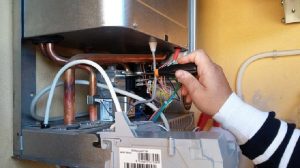Hot water works wonders for tired muscles, relaxes us from within, and washes off the accumulated stress. Many people cannot imagine a life where water heaters aren’t a part of their everyday lives. They heat your water quickly, efficiently, and conveniently and are of different types such as condensing, tankless, heat pump, conventional storage tank, and solar. An atmospheric water heater is a storage-tank water heater fueled by natural gas. But what is an atmospheric water heater in detail, how does it work, and what is its working mechanism? Read on to find out.
What Is an Atmospheric Water Heater?
As mentioned earlier, an atmospheric water heater is a gas-fuelled storage-tank water heater, and they are one of the most common water heating devices in residential homes. These heaters release their exhaust with the help of a vertical or upward sloping metal duct vent (venting systems are essential because they enable the release of harmful gasses). Since atmospheric venting involves the rise of hot air, it must have a vertical venting to allow the air to exit from your home. It is necessary to have an efficient exhaust gas release system because the gas could be hazardous to your health.
Difference between Atmospheric and Gas Water Heaters
Even though some people mistake an atmospheric and gas water heater to be the same thing, they are different. All gas water heaters utilize fossil fuels such as LPG, oil, or natural gas to heat the water. People prefer to use natural gas because it is more cost-efficient than electricity. Even though an atmospheric heater uses one of these three gasses to heat the water, it consists of a venting mechanism to enable the release of those gasses from your house (for instance, through a metal draft pipe situated above its tank). Since hot air naturally rises upwards, all gasses are released into the atmosphere effectively from your home.
Parts of an Atmospheric Heater
Atmospheric water consists of several parts, including the expansion tank, exhaust, pressure relief, and drainage. Here’s a brief introduction to them.
The Main Water Tank
The main water tank plays a vital role in the heating system because cold water enters from the pipe, which it sends to the bottom through a dip tube (a long tube that stretches from the cold water inlet to the tank’s base). Once the heater heats the water sufficiently, it rises to the top, where the hot water pipe releases it to various water sources inside your home. Main water tanks have two to three inches of insulation and a glass lining inside, preventing corrosion.
Burner
The burner carries out most of the heating process in an atmospheric water heater, usually located at the main water tank’s bottom. Burners are either made of steel (suitable for natural gas) or cast iron (suitable for propane or LPG gas). Whether they use natural gas or propane, all burners produce water vapor and carbon dioxide due to the gas combustion process. The burner jumps into action when you activate the pilot light. You can easily access its control module, situated on the tank’s side.
The information mentioned above has given you the answers you want regarding the questions like what is an atmospheric water heater, its parts, and its working mechanism. If you have not used these water heaters above, you could try them and see how they work for you.








